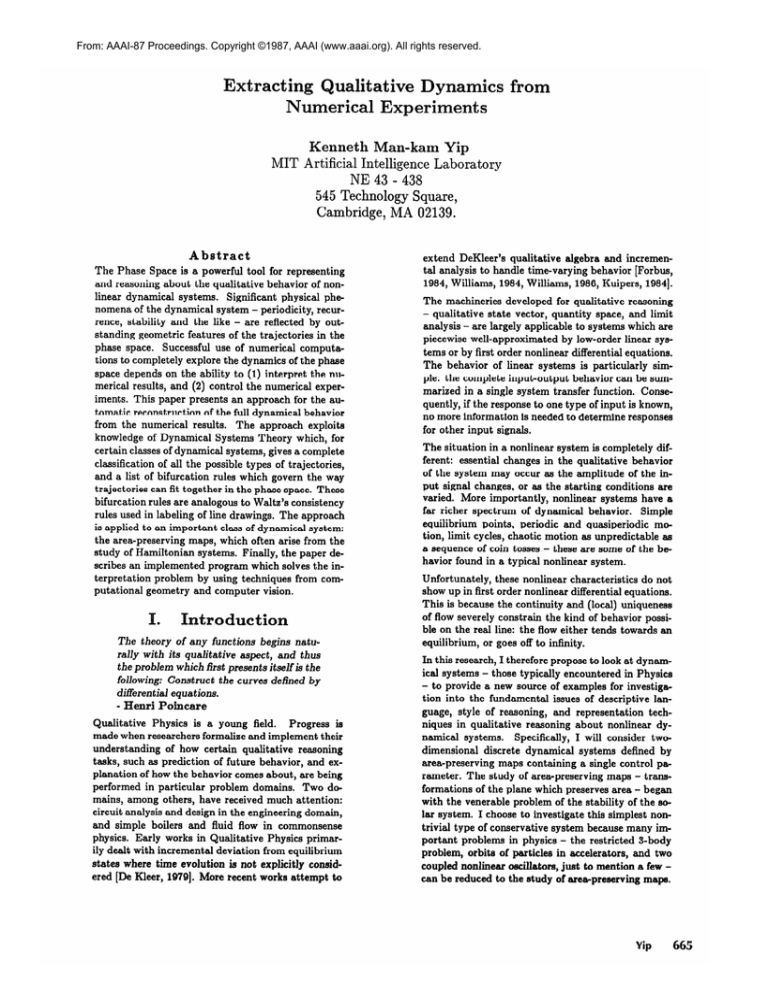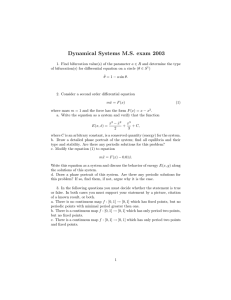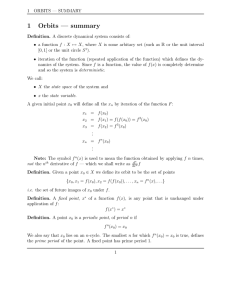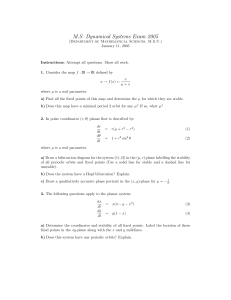
From: AAAI-87 Proceedings. Copyright ©1987, AAAI (www.aaai.org). All rights reserved.
Extracting
Qualitative Dynamics
Numerical Experiments
from
Kenneth Man-kam Yip
MIT Artificial Intelligence Laboratory
NE 43 - 438
545 Technology Square,
Cambridge, MA 02139.
Abstract
The Phase Space is a powerful tool for representing
and reasoning about the qualitative behavior of nonlinear dynamical systems. Significant physical phenomena of the dynamical system - periodicity, recurrence, stability and the like - are reflected by outstanding geometric features of the trajectories in the
phase space. Successful use of numerical computations to completely explore the dynamics of the phase
space depends on the ability to (1) interpret the numerical results, and (2) control the numerical experiments. This paper presents an approach for the automatic reconstruction of the full dynamical behavior
from the numerical results. The approach exploits
knowledge of Dynamical Systems Theory which, for
certain classes of dynamical systems, gives a complete
classification of all the possible types of trajectories,
and a list of bifurcation rules which govern the way
trajectories can fit together in the phase space. These
bifurcation rules are analogous to Waltz’s consistency
rules used in labeling of line drawings. The approach
is applied to an important class of dynamical system:
the area-preserving maps, which often arise from the
study of Hamiltonian systems. Finally, the paper describes an implemented program which solves the interpretation problem by using techniques from computational geometry and computer vision.
.
ntroduction
The theory Of any fUnCtiOns begins n8tur811y with its qualitative aspect, and thus
the problem which fist presents itself is the
following: Construct
the curves defined by
differential equations.
- Hem-i Poincare
Qualitative Physics is a young field.
Progress is
made when researchers formalize and implement their
understanding of how certain qualitative reasoning
tasks, such as prediction of future behavior, and explanation of how the behavior comes about, are being
performed in particular problem domains. Two domains, among others, have received much attention:
circuit analysis and design in the engineering
domain,
and simple boilers and fluid flow in commonsense
physics. Early works in Qualitative Physics primarily dealt with incremental deviation from equilibrium
states where time evolution is not explicitly considered [De Kleer, 19791. More recent works attempt to
extend DeKleer’s qualitative algebra and incremental analysis to handle time-varying behavior [Forbus,
1984, Williams, 1984, Williams, 1986, Kuipers, 19841.
The machineries developed for qualitative reasoning
- qualitative state vector, quantity space, and limit
analysis - are largely applicable to systems which are
piecewise well-approximated by low-order linear systems or by first order nonlinear differential equations.
The behavior of linear systems is particularly simple: the complete input-output behavior can be summarized in a single system transfer function. Consequently, if the response to one type of input is known,
no more information is needed to determine responses
for other input signals.
The situation in a nonlinear system is completely different: essential changes in the qualitative behavior
of the system may occur as the amplitude of the input signal changes, or as the starting conditions are
varied. More importantly, nonlinear systems have a
far richer spectrum of dynamical behavior.
Simple
equilibrium points, periodic and quasiperiodic motion, limit cycles, chaotic motion 8s unpredictable as
a sequence of coin tosses - these are some of the behavior found in a typical nonlinear system.
Unfortunately, these nonlinear Characteristics do not
show up in first order nonlinear differential equations.
This is because the continuity and (local) uniqueness
of flow severely constrain the kind of behavior possible on the real line: the flow either tends towards an
equilibrium, or goes off to infinity.
In this research, I therefore propose to look at dynamical systems - those typically encountered in Physics
- to provide a new source of examples for investigation into the fundamental issues of descriptive language, style of reasoning, and representation techniques in qualitative reasoning about nonlinear dynamical systems.
Specifically, I will consider twodimensional discrete dynamical systems defined by
area-preserving maps containing a single control parameter. The study of area-preserving maps - transformations of the plane which preserves area - began
with the venerable problem of the stability of the solar system. I choose to investigate this simplest nontrivial type of conservative system because many important problems in physics - the restricted j-body
problem, orbits of particles in accelerators, and two
coupled nonlinear osdletors, just to mention a few can be reduced to the study of are&preserving mape.
Yip
665
control parameter varies, I want my program to automatically generate a family of phase portraits describing the main dynamical properties of the map
for all initial conditions in U and parameter values in
T
J.
To explore the complete dynamics of a nonlinear sys
tern over a large region of the phase space and parameter space is a fairly typical problem in the physics
literature. A good illustration of this task is provided
by Henon’s well-known paper, “Numerical Study of
Quadratic Area-Preserving Mappings” [Henon, 19691.
The goal of Henon’s paper is to provide a description
of the main properties of the quadratic map:
Xn+l
=
x,cosa!-(y,-xi)sina
Yn+l
=
x=sina!+(y,
-xz)coso
where x and y are the state variables, and CYis the
control parameter. The main results of Henon’s paper are shown in Figures l(a)-(f),
which display the
output of many numerical simulations.
f(b)
.
Figure
.;:>,
1: A partial list of phase portraits from numerical
experiments. The figures are generated by plotting several
hundred of successive values of (xra,yn). (a) CY= 1.16 (b)
a! = 1.33 (c) a! = I.58 (d) CY= 2.0 (e) (;Y= 2.04 (f) CY= 2.21.
Dashed line: axis of symmetry.
The simplest
approach
to this problem
is the brute
force method: it divides the phase space and parameter space into small grids and tries every possible
combinations of initial conditions and parameter values. A simple calculation will show that this method
involves an enormous amount of computation.
For
instance, if we choose a uniform grid size of 0.01, we
have to compute approximately 300 x 300 x 600 = 54
million orbits. Assuming, on the average, 0.02 second
is needed to compute 8 trajectory of 500 points, it will
take over 300 hours of computation time to compute
all the trajectories.
The brute force method suffers from two serious problems. First, it is grossly inefficient because most of
the phase portraits computed will be qualitatively the
same. Second, it is not reliable because there is always the danger of missing some important qualitative features when the change occurs at a resolution
finer than the grid size.
A physicist often does much better than this. Figure 2 represents a flow-chart of what a professional
physicist does during the numerical experiment. The
flow-chart has two nested loops. The outer loop involves deciding when to stop the experiment; the inner loop, when to move on to next parameter value.
Controlling what experiment to do next, and interpreting the results of the simulation - these are the
two most important decisions the experimenter has
to make.
tia conditions and parameter values. The key observation is that knowledge of qualitative dynamics
and their geometric manifestations in the phase space
provides a strong constraint on the type of behavior possible. As we will see in the next section, this
constraint translates into a dramatic reduction of the
amount of search required to find those combinations
of initial states and parameter values that lead to
9nteresting” phase portraits.
Terminology
A.
The purpose of this section is to introduce some concepts and definitions from Dynamical Systems Theory [Hirsch and Smale, 19741. A dynamical system
consists of two parts: (1) the system state, and (2)
the evolution law. The system state at any time to
is a minimum set of values of variables {XI, . . . , x,)
which, along with the input to the system for t 2 to, is
sufficient to determine the behavior of the system for
all time t 1 to. The variables which define the system
state are called state variables. The conceptual ndimensional space with the n state variables as basis
vectors is called the phase space. A state vector is
a set of state variables considered as a vector in the
phase space. As the system evolves with time, the
state vector traces out a path in the phase space; the
path is called an orbit or a trajectory.
Finally, 8
phase portrait is a partition of the phase space into
orbits.
The evolution law determines how the state vector
evolves with time. In a finite dimensional discrete
time system, the evolution law is given by difference
equations. The difference equation is specified by a
function f : X --) X where X is the phase space
of the discrete system. The function f which defines
a discrete dynamical system is called a mappinrg,
or 8 map, for short. The multipliers of the map
f are the eigenvalues of the Jacobian of f. An areapreserving
map is a map whose Jacobian has a unit
determinant.
The set of iterates off-z,
f(x), f2(x), f’(x), . ..) f”(z)
- as n becomes large is called the orbit of x relative
to q it captures the history of x as f is iterated.
Two types of point have the simplest histories - fixed
point, and periodic point.
The point x is a dxed
point of f if f(x) = x. A fixed point x is called &able, or elliptic, if all the multipliers of f at x lie on
the unit circle; it is called unstable, or hyperbolic,
otherwise. The point x is a periodic point of period n if p”(x) = x. The least positive n for which
f”(x) = x is called the period of x. The set of all
iterates of a periodic point forms a periodic orbit.
Figure 2: How-chart which describes the process of experimenting with a dynamical system.
The task of behavior prediction can now be summarized as this: to develop a picture of all possible solutions to the dynamical system from a limited amount
of numerical experiments at a limited number d ini-
.
Qualitative
ynamics
and
their
Types of Orbit
ve 8 brief outline of
rbits in area-preserv
Yip
667
There are four ways in which an orbit generated by
infinitely many iterations of the map can be explored
in the phase space:
1. A finite number of N points are encountered repeatedly, corresponding to a periodic orbit of
period N.
2. The iterates fill a smooth curve, which is a topological circle, in the phase space. This curve is
called an invariant curve because the whole
curve maps onto itself under the action of the
map.
3. The iterates can form a random splatter of
points that fills up some area of the phase space.
This happens when the orbit evolves in a chaotic
manner whose detail depends sensitively on the
initial conditions.
S-kiss is often preceded by extremal bifurcations in
a region a bit further away from the original elliptic
fixed point, resulting in the formation of a pair of
elliptic and hyperbolic period-3 points.
The dynamics of the area-preserving maps severely
constrain the way orbits can fit, together in the phase
portraits.
These constraints, which are encoded in
the bifurcation patterns, are thus analogous to the
consistency rules for line labeling in Waltz’s thesis
[Waltz, 19751. A s we shall see later, the geometry of
bifurcation allows us to decide whether a collection of
phase portraits is consistent, and gives us clue to the
types and locations of orbits that the program should
be looking for.
4. The iterates leave the phase space after a finite
number of iterations and escape to infinity in the
end. These points are called escape points.
Since the dynamics of are&preserving
maps and
Hamiltonian systems have a lot in common, these
four types of geometric orbit have important physical
interpretations.
Due to space limitation, I just lit
the interpretations below. The explanation of these
interpretations can be found in [Yip, 19871.
periodic points
invariant curve
chaotic region
escape points
_
_
++
C
2.
Bifurcations:
in the phase portrait
Biication
Discrete Flow Pattern
Type
periodic motion
quasiperiodic motion
chaotic motion
unbounded motion
Qualitative
changes
Two phase portraits are qualitatively equivalent
if there exists a homeomorphism between them which
preserves fixed points, periodic points, invariant
curves, and their stability. Bifurcation is said to occur when the dynamical system goes through a qualitative change in its phase portrait as the control parameter is varied. I will focus on one important type
of bifurcation: appearance and disappearance of periodic orbits.
Meyer Meyer, 19701 gives a complete classification
of fhe generic bifurcations of periodic points for oneparameter area-preserving maps. Meyer has shown
that generic bifurcations occur when the multiplier
x
nth root of unity where n = 1, 2, 3, 4, and
1 F The five types of generic bifurcation are: (1)
extremal, (2) transitional, (3) phantom 3-k&
(4)
phantom Ckiss, and (5) emission. Because of space
limitation, I only discuss the case of phantom J-~&W
as an illustration of what the bifurcation geometry is.
Again, detail of this can be found in [Yip, 19871.
Phantom 3-kiss occurs when the multiplier X of the
map is a cube root of unity. The region of stability
of the elliptic fixed point shrinks to zero aa the hyperbolic points of an unstable period-3 cycle “kiss”
at, the origin. After the Ukiss”, the fixed point turns
elliptic again, and a new unstable period-3 cycle is
emitted. Note the change in orientation of the trimg&r region around the elliptic point. The phantom
66%
Engineering Problem Solving
Figure 3: Five Generic types of Bifurcation
Geometry.
A periodic point bifurcates whenever its multipliers pass
through an n-th root of unity.
IV.
A.
The Control
How
to
start
the
Problem
numerical
ex-
periment?
Elliptic fixed points are good places to start. We expect that the orbits near an elliptic fixed point, where
the linear terms of the map dominate, will be mostly
How can one recognize the or1. Orb2 Type.
bit type - a O-dimensional finite point set
whose elements are encountered repeatedly, a ldimensional smooth curve, or a 2-dimensional
region - of a set of iterates?
invariant curves. We then search radially outward until we encounter island chains, and eventually chaotic
regions.
B.
to
Mow
try
to
decide
what
experiment
2. Clustering.
How can one determine the number
of islands in an island chain? This number gives
the period of the enclosed periodic point.
next?
Knowing the generic bifurcation patterns is valuable
for controlling numerical experiments. To begin with,
it is difficult, to locate the value of the control parameter at which bifurcation occurs: it is of probability almost zero that a randomly chosen point in the
(z,y, Q) space will be the bifurcation point. But the
pattern of flow near a periodic point just before and
after the bifurcation occurs in a finite range of the
control parameter; hence the pattern is easier to detect during the experiments.
Once a given flow pattern is found to match some
parts in our library of bifurcation geometries, it will
give us strong evidence that the corresponding bifurcation exists, and we should be able to locate the rest
of the flow patterns as given by the generic bifurcation. The pre-stored knowledge abouf these bifurcations gives us the complete information about what
geometric objects, and approximately where in the
control parameter space to look for.
3. Area and Centroid.
How can one estimate the
centroid and area enclosed by the curve? The
centroid is a good approximation of the location
of the enclosed periodic point,. The area gives a
measure of saliency of the island chain.
4. Shape. How can one recognize the shape of a
curve? For example, is it, a 3-sided figure resembling a triangle?
In the following, I will show how these four problems
can be solved by applying techniques from computational geometry and computer vision. Euclidean minimal spanning tree (EMT)
[Preparata and Shamos,
19851, and scale space image [Witkin, 19831 - these
are the two important data structures used by the interpretation program. The main processing steps are
a8 follows (see figure 4).
To take an example, consider the phantom S-k&w seen
in figure Id. The local flow pattern around the fixed
point matches that in figure 3. According to the bifurcation pattern, the regular region around the stable
fixed point will shrink in size, becoming an unstable
fixed point; eventually, a new stable fixed point is
born. So, we should expect to see figure If at some a
slightly greater than two.
c.
nate
Mow
the
to
decide
when
to
termi-
experiments?
Besides imposing a strong constraint on what can be
expected to happen in the phase portrait, the generic
bifurcations also provide an answer to the problem
a simulation
experiment is incomof termination:
plete unless all the major qualitative features in the
phase portrait can be explained by this finite list of
local generic bifurcations.
An example is the change
of stability of a fixed point. Suppose we have numerically located the 3-island chain and the center
elliptic point at some ar = CYOas in figure Id. We
know that the family of phase portraits is yet incomplete because we expect a phantom S-kiss bifurcation
to occur. In particular, we need to try at least two
more experiments to obtain two phase portraits: first,
ati Q = CYIwhen the triangular region is flipped, and
second, at (~2 E (cYo,c~~) when the region becomes
vanishingly small, indicating instability of the fixed
point.
Figure
4: Main
processing
steps
for solving the in terpl -eta-
tion problem
e Step 1. The program computes a EMST from
the input point set, using the Prim-Dijkstra algorithm.
e Step 2. The program detects clusters in the
EMST by
for edges in l&hetree that
are significantly longer than nearby edges. Such
looking
Yip
669
edges are called incontistent [Zahn, 19711. The
criterion of edge inconsistency
suggested by
Zahn is used to detect inconsistent edges. Inconsistent edges are then deleted, breaking up the
EMST into connected sub-components.
These
sub-components
are collected by a depth-first
tree walk.
Step 9. For each sub-tree of the EMST, the program examines the degree of each of its nodes,
where the degree of a node is the number of
nodes connected to it in the sub-tree.
For a
smooth curve, the EMST consists of two terminal nodes of degree one; the rest, degree two.
For a point set that fills an area, its corresponding EMST consists of many nodes having degree
three or higher.
l
e Step 4. To compute the area and centroid of
the region bounded by a curve, the program
generates an ordered sequence of points from
the EMST, and spline-interpolates the sequence
to obtain a smooth curve. The smooth curve
is encoded using chain coding [Freeman, 19611.
Straightforward algorithms are then applied to
compute the area and centroid.
l
Step 5. A curve is parameterized by C(s) =
(s(s), y(s)) where s is the arc length along the
curve. The two functions x(s) and y(s) are computed from the chain code representation. Then,
x(s) and y(s) are smoothed by the Gaussian and
its first two derivatives at multiple spatial scales.
Finally, the zero-crossings of the curvature function R(S), and the signs of it(s) are computed to
determine the locations and type of the extrema.
Examples of orbit recognition
19871.
VI.
can be found in [Yip,
Summary
In this paper, I have studied the task of qualitative
analysis of nonlinear area-preserving map by numerI have also described how to ap
ical experiments.
preach the two major problems in automating the experimenting process: (1) experiment control, and (2)
result interpretation.
The basic idea is that knowledge of qualitative dynamics and bifurcations provides a strong constraint on the type of behavior
possible. Finally, I have described a program which
solves the interpretation problem by using techniques
from computational geometry and computer vision.
ACKNOWLEDGMENT
The content of this paper benefited from many discussions with Gerald Sussman, Hal Abelson, and Jack
Wisdom. Ken Forbus and Brian Williams taught me
their views of Qualitative Physics. I also thank General Electric for their financial support during this
research.
References
[De Kleer, 19791 Johan De Kleer. Causal and teleological recrsoningin circuit recognition.
A.&
670
Engineering Problem Solving
TR 629, Massachusetts Institute of Technology,
Artificial Intelligence Laboratory, 1979.
[Forbus, 19841 Kenneth Dale Forbus.
Qualitative
Artificial
Intelligence, 24:83process theory.
168, 1984.
[Freeman, 19611 H. Freeman. On the encoding of arIRE, Trans.
bitrary geometric configurations.
Electron. Cornput., EC-lo, 1961.
[Henon, 19691 M. Henon.
Numerical
quadratic area-preserving mappings.
of Applied Mathematics,
27, 1969.
study of
Quarterly
[Henon, 19811 M. Henon. Numerical exploration of
hamiltonian systems. In Chaotic behavior of Deterministic Systems, North-Holland, 1981.
[Hirsch and Smale, 19741 M.W. Hirsch and S. Smale.
Diflerential Equations, Dynamical Systems, and
Linear Algebra. Academic Press, 1974.
[Kuipers, 19841 Benjamin Kuipers.
Commonsense
reasoning about causality:
Deriving behavior
from structure.
Artificial Intelligence,
24:169204, 1984.
[Meyer, 19701 K.R. Meyer.
Generic bifurcations
l%ansactions
of American
of periodic points.
Mathematical
Society, 149, 1970.
[Preparata and Shamos, 19851
Franc0 Preparata and Michael Shamos.
Computational Geometry. Springer-Verlag, 1985.
[Waltz, 19751 David Waltz.
Understanding
line
drawings of scenes with shadows. In The Psychology of Computer Vision, McGraw-Hill, 1975.
(Williams, 19841 Brian Williams.
Qualitative analysis of mos circuits.
Artificial
Intelligwace,
24:281-346, 1984.
[Williams, 19863 Brian Williams.
Doing
time:
putting qualitative reasoning on firmer ground.
In Proceedings AAAI-86,
American Association
for Artificial Intelligence, 1986.
[Witkin, 19831 Andrew Witkin.
Scale-space filtering.
In Proceedings IJCAI-89,
International
Joint Conference on Artificial Intelligence, 1983.
[Yip, 19871 Kenneth Yip. Extracting Qualitative Dynamics from Numerical Experiments. AIM 950,
Artificial Intelligence Laboratory, Massachusetts
Institute of TechnoIogy, 1987.
[Zahn, 19711 C.T. Zahn.
Graph-theoretical
methods for detecting and describing gestalt clusters.
IEEE Transactions
on Computers, 29, 1971.








